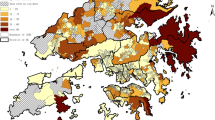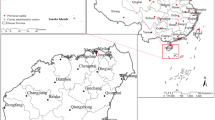Abstract
Spatial equality of access to basic public services, especially medical care services which are directly related to life safety, is the first step to achieve the goal of equalization of basic public services for all the people proposed by central government of China. Using the spatial analysis and the statistical analysis, this study evaluates the spatial differentiation of medical care facilities accessibility by constructing STT (Shortest Travel-Time) and SAI (Spatial Accessibility Index). And then this study explores the neighborhood effects on the medical care facilities accessibility in Beijing, with a particular focus on the effect of neighborhood migrant proportion by constructing spatial dependent regression model. The spatial accessibility analysis of medical care facilities show that the spatial distribution of medical care facilities was basically consistent with administrative regions but not with population demands. Bivariate LISA cluster maps identify that suburban areas are the overlapped clusters of high percent of migrants and limited medical care services. This is associated with the public service allocation rule in China, which stresses equality within urban areas and within rural areas but overlooks equality between urban areas and rural areas; and stresses local resident demands but overlooks migrant demands. To estimate the effects on medical care accessibility of neighborhood migrant proportion, spatial dependence models are applied due to spatial dependence of accessibility of medical care facilities. The regression results show that neighborhoods with high percent of migrants, even conditioning on neighborhood SES, are related to limited spatial accessibility of medical care services. Besides neighborhood characteristics, another important factor influencing spatial accessibility of medical care services is the process of spatial spillover effects. This indicates that the attenuate accessibility of medical care services for migrants is not only because of their own constraints but also because of their proximity to other disadvantaged neighborhoods. Therefore, it is urgently needed to increase the medical facilities in the suburban areas, to take into account migrants’ demands and to reduce residential segregation between local residents and migrants for local governments to achieve the goal of equalization of medical care service.
Similar content being viewed by others
References
Anselin L, 1995. Local indicators of spatial association: LISA. Geographical Analysis, 27(2): 93–115.
Anselin L, Florax R J G M, Rey S J, 2004. Advances in spatial econometrics. Springer-Verlag, 2004.
Center for Health Statistics and Information, NHFPC. Analysis report of national health services survey in China. Available at: http://www.nhfpc.gov.cn/mohwsbwstjxxzx/s8211/201610/9f109ff40e9346fca76dd82cecf419ce.shtml. 2016-10-26. (in Chinese)
Chen Li, Zhang Wenzhong, Yang Yizhao, 2013. Residents’ incongruence between reality and preference of accessibility to urban facilities in Beijing. Acta Geographica Sinica, 68(8): 1071–1081. (in Chinese)
Eicher C L, Brewer C A, 2001. Dasymetric mapping and areal interpolation: implementation and evaluation. American Cartographer, 28(2): 125–138.
Feng J, Wang F, Zhou Y, 2013. The spatial restructuring of population in metropolitan Beijing: toward polycentricity in the post-reform era. Urban Geography, 30 (7): 779–802. (in Chinese)
Feng J, Zhou Y, 2008. Restructuring of socio-spatial differentiation in Beijing in the Transition Period. Acta Geographica Sinica, 63(8): 829–844. (in Chinese)
Fu Jiasen, Wang Li, Zhao Dongxia et al., 2014. Access the accessibility of public medical care facilities: a case sty of Dalian. Health Economics Research, (11): 27–30. (in Chinese)
Gao Junbo, Zhou Chunshan, Jiang Haiyan et al., 2010. The research on the spatial differentiation of the urban public service facilities distribution in Guangzhou. Human Geography, 25(3): 78–83. (in Chinese)
Hart J T, 1971. The inverse care law. The Lancet, 297(7696): 405–412. doi: 10.1016/S0140-6736(71)92410-X
Huang Y Q, Jiang L W, 2009. Housing inequality in transitional Beijing. International Journal of Urbanand Regional Research, 33(4): 936–956. doi: 10.1111/j.1468-2427.2009.00890.x
Kirby J B, Kaneda T, 2005. Neighborhood socioeconomic disadvantage and access to health care. Journal of Health and Social Behavior, 46(1):15–31.
Kirby J B, 2008. Poor people, poor places and access to health care in the United States. Social Forces, 87(1): 325–355.
Logan J R, Bian Y J, Bian F Q, 1999. Housing inequality in urban China in the 1990s. International Journal of Urban and Regional Research, 23(1): 7–25. doi: 10.1111/1468-2427.00176
Macintyre S, Maciver S, Sooman A, 1993. Area, class and health: should we be focusing on places or people? Journal of Social Policy, 22(2): 213–234. doi: 10.1017/S0047279400019310
Macintyre S, 2007. Deprivation amplification revisited; or, is it always true that poorer places have poorer access to resources for healthy diets and physical activity? International Journal of Behavioral Nutritionand Physical Activity, 4: 32. doi: 10.1186/1479-5868-4-32
Mennis J, 2003. Generating surface models of population using dasymetric mapping. Professional Geographer, 55(1): 31–42.
Qi Lanlan, Zhou Suhong, Yan Xiaopei, 2014. Endpoint attractive factors of medical facilities’ accessibility: based on GPS floating car data in Guangzhou. Scientia Geographica Sinica, 34(5): 580–586. (in Chinese)
Radke J, Mu L, 2000. Spatial decompositions, modeling and mapping service regions to predict access to social programs. Geographic Information Sciences, 6(2): 105–112. doi: 10.1080/10824000009480538
Sampson R J, Morenoff J D, Gannon-Rowley T, 2002. Assessing ‘neighborhood effects’: social processes and new directions in research. Annual Review of Sociology, 28(1): 443–478.
Small M L, Jacobs E M, Massengill R P, 2008. Why organizational ties matter for neighborhood effects: resource access through childcare centers. Social Forces, 87(1): 387–414.
Song Zhengna, Chen Wen, 2009. Measuring spatial accessibility to health care facilities based on potential model. Progress in Geography, 28(6): 848–854. (in Chinese)
Wang F, Luo W, 2005. Assessing spatial and nonspatial factors for healthcare access: towards an integrated approach to defining health professional shortage areas. Health & Place, 11(2): 131–146.
Wang Lijuan, 2014. Research on Spatial Equity of Urban Public Facilities: A Case Study of Chongqing. Chongqing: Chongqing University. (in Chinese)
Wang Xingping, Hu Pan, Shen Sisi et al., 2014. Spatial characters of public service facilities from social differentiation viewpoint. Planner, 30(5): 17–24. (in Chinese)
Wang Y P, Wang Y L, Wu J S, 2010. Housing migrant workers in rapidly urbanizing regions: a study of the Chinese model in Shenzhen. Housing Studies, 25(1): 83–100. doi: 10.1080/02673030903362019
Wilson W J, 1987. The Truly Disadvantaged. Chicago: The University of Chicago Press.
Wu F L, 2002. Sociospatial differentiation in urban China: evidence from Shanghai’s real estate markets. Environment and Planning A, 34(9): 1591–1615. doi:10.1068/a34196
Wu anjun, Kong Yunfeng, Li Bin, 2008. The spatial accessibility analysis of rural medical facilities based on GIS: a case study of Lankao county, Henan Province. Human Geography, 23(5): 37–42. (in Chinese)
Wu W P, 2008. Migrant settlement and spatial distribution in metropolitan Shanghai. The Professional Geographer, 60(1): 101–120. doi: 10.1080/00330120701724210
Yin Haiwei, Xu Jian’gang, 2009. Spatial accessibility and equity of parks in Shanghai. Urban Studies, 16(6): 71–76. (in Chinese)
Zhong Shaoying, Yang Xin, Chen Rui, 2016. The accessibility measurement of hierarchy public service facilities based on multi-mode network dataset and the two-step 2SFCA: a case study of Beijing’s medical facilities. Geographical Research, 35(4): 731–744. (in Chinese)
Zhou Haiqing, Gao Dandan, Chang Wenhu et al., 2011. Demand of floating population for health service and the utilization in one district of Beijing. Chinese General Practice, 14(4): 373–376. (in Chinese)
Author information
Authors and Affiliations
Corresponding author
Additional information
Foundation item: Under the auspices of National Natural Science Foundation of China (No. 41701151), MOE (Ministry of Education in China) Project of Humanities and Social Sciences (No. 17YJCZH256), Doctoral Project of Tianjin Normal University (No. 52XB1621)
Rights and permissions
About this article
Cite this article
Zhao, M., Liu, S. & Qi, W. Spatial Differentiation and Influencing Mechanism of Medical Care Accessibility in Beijing: A Migrant Equality Perspective. Chin. Geogr. Sci. 28, 353–362 (2018). https://doi.org/10.1007/s11769-018-0950-x
Received:
Accepted:
Published:
Issue Date:
DOI: https://doi.org/10.1007/s11769-018-0950-x




